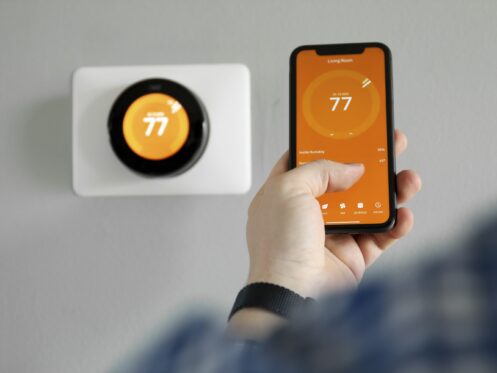The U.S. Department of Energy (DOE) recommends advanced thermostat control for all American homes due to the energy savings. Let’s explore how a smart thermostat can easily pay for itself and save you money.
ENERGY STAR
ENERGY STAR is a joint program run by the DOE and the U.S. Environmental Protection Agency (EPA). The DOE sets minimum energy efficiency standards. The EPA sets even higher standards. They’re not legal requirements, but products that achieve them through independent lab testing receive certification. That certification gives you peace of mind that the smart thermostat you choose delivers the savings the marketing claims it does.
Scheduling
Scheduling is the key reason the DOE recommends advanced thermostats for all homes. Programmable thermostats allow you to set schedules for automatic temperature control. The DOE estimates that an optimal schedule can lower any household’s annual heating and cooling costs by up to 10%. For these savings, the DOE recommends increasing or decreasing your temperature by 7 to 10 degrees Fahrenheit for at least eight hours a day. Actual savings can be much higher if you exceed that recommendation and take advantage of other energy-saving features your smart thermostat has.
Adaptive Learning
Many smart thermostats can help you save even more through machine learning. Such features have become even more powerful through artificial intelligence and cloud computing. One example is thermostats that can monitor household behavior and optimize schedules automatically. There are already models you don’t have to set and that program themselves within several days of use. Another example is smart setback. HVAC systems use more energy to achieve a particular temperature than maintain it. Many smart thermostats can monitor these transitional periods and adjust them for the best energy performance.
Modes and Profiles
Programmable thermostats often have modes and profiles that make the scheduling feature more robust. You could, for instance, have one schedule for weekends and another for weekdays. Some users may need a different profile for each day of the week. Hold mode is a ubiquitous feature. It lets you override the current schedule. That can be useful on days when you work from home rather than go into the office. Vacation mode is another common example. It can save you significant money whenever you’re away from home for 48 hours or more.
Occupancy Sensing
Geofencing is a smart thermostat feature that can make scheduling even more effective. Set schedules aren’t practical for all households, and you can use geofencing instead of scheduling. How it works is that the thermostat creates a virtual boundary around the home. It also tracks household members through a technology like GPS or RFID. The thermostat can then use one schedule when you’re occupying the home and another when you’re not.
Energy Monitoring and Insights
Excessive energy usage is often the earliest sign of an HVAC problem. That’s why the HVAC industry encourages monitoring your heating and cooling bills month to month and year to year. Many utilities offer opt-in programs through which you can receive text alerts for high usage. An even better solution is a smart thermostat with energy monitoring. These systems can alert you to high usage within hours. They can also provide insight into how to make your home even more energy efficient.
Remote Access and Control
The key difference between a smart thermostat and a programmable thermostat is Wi-Fi capability. Connecting to your local home network and the internet opens up many possibilities for advanced features. It also means that you can access and control your thermostat wherever you are. Leave on a trip and forget to put the thermostat in vacation mode? It’s not a problem since you can enable it from your phone.
Remote Sensors
Many thermostat manufacturers make models that support remote sensors. With this feature, thermostat location is no longer important from a temperature-sensing perspective. You can install your thermostat wherever it’s most convenient. Multiple thermal sensors provide a much more accurate reading. You can also integrate other sensors, including:
- Smoke
- Indoor air quality
- Relative humidity
- Carbon monoxide
Zone Control
Remote sensors are integral to HVAC zoning. This is where we organize a central heating and cooling system into separate zones with independent control. Zoning lets you personalize comfort for bedrooms, bathrooms, kitchens, living rooms, and other rooms. Zone control can reduce energy usage by 30% or more over traditional central HVAC. It also promotes better air quality. Volatile organic compounds created when cooking, for instance, won’t make it from the kitchen into the other living areas.
Rebates
Another benefit of choosing an ENERGY STAR thermostat is that rebates may be available. You may even be able to claim multiple rebates from different sources. Those offers can significantly reduce the cost of your new thermostat or even pay for it entirely. You can check for rebates available in your area by zip code through the ENERGY STAR website. We also recommend checking the website of your local electric company and other utilities.
Demand Response Programs
Many local electric companies offer demand response programs to lower energy usage during peak periods. Participation is optional and requires a smart thermostat that supports that particular program. If you opt-in, you give your provider permission to adjust your thermostat by up to several degrees during peak periods. In return, you receive benefits, which are often in the form of bill credits.
Time of Use Savings
Many electric companies charge different rates based on the time of day and season. Some smart thermostats have internet-enabled rate awareness. They can then use that information to adjust your thermostat automatically during those peak periods. Some models can even monitor the weather via the internet. This is useful in areas prone to sharp temperature changes. If there’s an incoming cold front, for example, the thermostat can save money by adjusting the heat gradually.
Maintenance Reminders and Predictive Maintenance
Your smart thermostat can remind you to change your filter. Some are even sophisticated enough to detect the need based on changes in static air pressure. A smart thermostat can alert you to schedule an HVAC tune-up early in the spring and fall. Predictive maintenance is an increasingly common feature that will change residential HVAC in the future. Through this feature, the thermostat monitors system performance. It can then alert you to schedule a diagnostic when the system begins operating outside normal parameters.
Smart Home Integration
Smart thermostats are smart devices, which means that they can communicate with other smart devices. Your smart thermostat can connect to your home automation hub. It can also coordinate with your other home automation devices, including smart:
- Vents
- Ceiling fans
- Blinds and shades
- Refrigerators and freezers
Install a Smart Thermostat in Bellingham
Marr's Heating and Air Conditioning has served Bellingham, WA and the surrounding areas since 1965. We offer a wide range of top smart thermostats from brands like Carrier, Ecobee, Honeywell, and Nexia. Our technicians install and service furnaces, heat pumps, air conditioners, ductless mini-splits, and gas stoves. We install, repair, seal, insulate, and clean ducts. You can count on us for mechanical ventilation systems, air purifiers, germicidal lights, humidifiers, and dehumidifiers. We also install and service tank and tankless water heaters.
If you have questions or want to schedule a service appointment or in-person consultation, contact us today.

